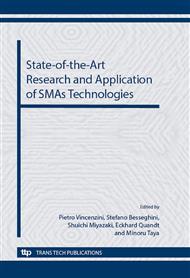p.69
p.75
p.81
p.87
p.92
p.103
p.113
p.119
p.125
SMA Dampers for Cable Vibration: An Available Solution for Oscillation Mitigation of Stayed Cables in Bridges
Abstract:
Several solutions have been proposed to mitigate the vibrations of stay cables in bridges, which are subjected to wind, rain and traffic loads. One possible solution relates to the use of semi-active devices, such as the ones based on magneto-rheologic fluids. These devices need guaranteed electrical power, together with computational effort and technical attention. In contrast, shape memory alloy (SMA) wires were studied for application as passive elements. In the present work, the properties of SMA that are required to realize dampers provided with an appropriate reliability are discussed. In particular, the fatigue/fracture life of the SMA wires and the thermal effects induced by both external temperature and the self-heating process are studied. The SMA dampers were applied to stayed cables of realistic size and tested in "facilities." Namely, the cables No 1 of 45 m length available at the ELSA-JRC in Ispra, Italy, and the 50 m cable of IFSTTAR near Nantes, in France, were considered. The experimental results establish a reduction of the vibration amplitude to one half or less than the one observed in the un-damped case. Furthermore, the installation of the SMA dampers causes an increase of the cable frequency. Performing a Windowed Fourier Transform or a Wavelet Transform analysis the evolution of frequency with the signal amplitude was studied. The change of amplitude produces a change of stiffness in the SMA. The adoption of an appropriate phenomenological model of the hysteresis cycle permits to perform numerical simulations using standard Finite Elements Analysis tools such as, for instance, the ANSYS software.
Info:
Periodical:
Pages:
92-102
Citation:
Online since:
September 2012
Keywords:
Price:
Сopyright:
© 2013 Trans Tech Publications Ltd. All Rights Reserved
Share:
Citation:


